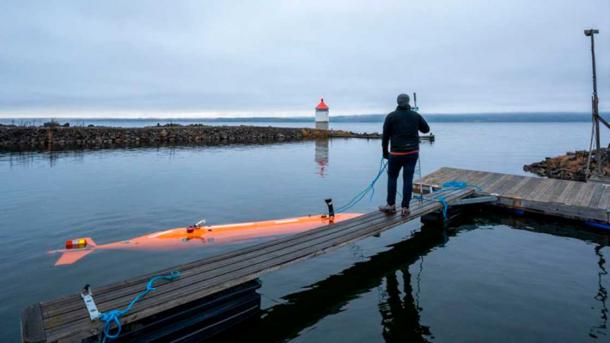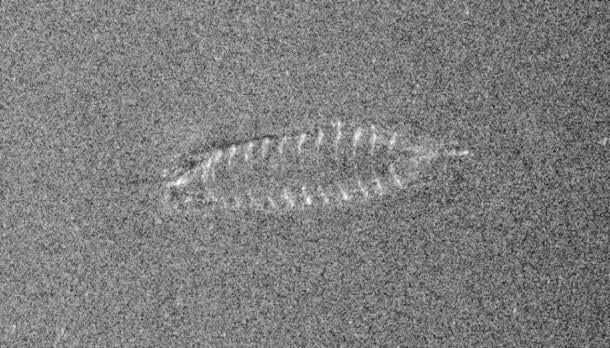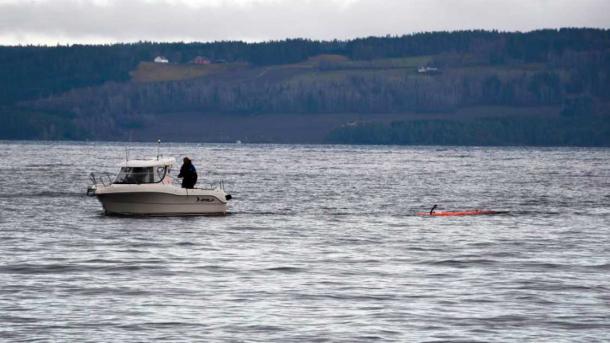
Sonar Spots Up To 700-Year-Old Shipwreck Deep in Norwegian Lake
Marine archaeologists from the Norwegian University of Science and Technology (NTNU) have discovered the sunken remains of what looks like a medieval-era shipwreck 1,350 feet (410 m) below the pristine surface of Lake Mjøsa.
A sonar sweep of the depths of the Norwegian lake, approximately 60 miles (100 km) north of Norway’s capital city of Oslo, returned striking acoustic images of the broken hull of the long-lost wooden ship. An initial analysis appears to show that the shipwrecked vessel would have been about eight feet (2.5 m) wide and 33 feet (10 m) long from stem to stern.
- Secrets of 829-Year-Old Post-Viking-Era Shipwreck Revealed
- Viking Ships: More than Fearsome Weapons of the Open Seas
The distinguishing features of the shipwreck have led experts to conclude that the ship was not built recently. In fact, its characteristics suggest it may have been constructed as long as 700 years ago, during a time when Norwegian shipbuilders had finally begun to depart from the traditional ship model associated with the Vikings.
“We only have the acoustic [sonar] images of the wreck,” NTNU maritime archaeologist Øyvind Ødegård told Live Science. “But it appears from the data that there is the outline of something that possibly could be a stern—and if that's the case, then that doesn't really appear until the 1300s.”

The team has been using sonar images of the shipwreck made by an autonomous underwater vehicle that's being used to map the location of surplus ammunition dumped on the floor of the vast lake. (FFI / NTNU)
Investigating a Murky Image of a Shipwreck
The discovery has so far created more questions than answers. What was the name of this ship, where did it come from and what was its purpose? Will they ever discover in exactly what year it was built and launched? At this stage, the archaeologists have been unable to answer any of these questions.
One obstacle they’ve had to deal with is the weather. November in Norway can be far from hospitable. Rough seas and frosty temperatures have prevented researchers from getting out on the water to investigate the shipwreck with a submersible camera. Unfortunately, the archaeologists will have to wait until next spring before they can get back out onto the water to get a closer look at what is left of the sunken vessel.
The sonar images of the shipwreck are helpful, however. They show the outline of a distinctive clinker-built ship, a traditional type of Norse or Scandinavian boat that has overlapping planks along the hull. This design was used by the Vikings, but on this particular sunken ship the steering oar was at the center-back of the ship instead of on the right side, which signifies post-Viking manufacture.
Later in the medieval period Norse shipbuilders developed an entirely new type of planking style for hull construction. So the wrecked ship can be most properly placed in the earlier Middle Ages, circa the 14th century, although not in a specific year.

The image of the shipwreck shows what looks like a stern, and a steering arm, later developments in shipbuilding. (FFI / NTNU)
Uncovering the Mysteries of Norway’s Inland Sea
This marvelous shipwreck discovery was made during an ongoing series of joint underwater expeditions carried out by the marine archaeologists from NTNU and personnel from the Norwegian Defense Research Establishment. The two sides have been officially collaborating on a mapping project designed to scan the bottom of Lake Mjøsa, a 140-square-mile (360 sq km) inland lake which had not been examined beyond the safe scuba diving limit of 65 to 98 feet (20 to 30 m).
On the government side, the primary purpose of this mission has been to find ammunition and explosive devices that were illegally dumped in the lake by a munitions factory between the 1940s and the 1970s. For their part, the archaeologists have always been primarily interested in searching for shipwrecks. “We realized that the entire lake is more or less unknown territory,” Ødegård said, explaining his team’s interest in the collaboration.
While it is located inland, Lake Mjøsa was a busy maritime thoroughfare for many centuries. It was used to facilitate ship-based trade in the region starting during the Viking Age (the 8th through the 11th centuries), with port cities forming along its banks to take advantage of the possibilities.
The area around the Norwegian lake was filled with rich farmland for growing and generous supplies of highly-coveted natural resources, while the trading center and capital city of Oslo, which was founded in the 11th century, was always well within walking or riding distance. “Mjøsa is like a mini-ocean, or a really large fjord,” Øyvind Ødegård explained to an interviewer from Science Norway.
Right from the beginning of the project, everyone involved knew there would be sunken ships. Even at the lightly explored depths of 65 to 98 feet (20 to 30 m), archaeologists had already registered nearly 20 shipwreck sites with cultural authorities. “We believed that the chance of finding a shipwreck was quite high, and sure enough, a ship turned up,” Ødegård stated.
It was the Norwegian Defense Research Establishment that provided the equipment responsible for the find. They deployed an autonomous underwater vehicle known as Hugin to map the lake’s floor, and after studying the results of their survey of 15 square miles (40 sq km) of lake bottom they discovered the mysterious medieval vessel. At a murky and impenetrable depth of more than 1,300 feet (400 m), it would have been impossible to spot the shipwreck without the assistance of sound navigation and ranging equipment.

View of Lake Mjøsa in Norway, where the shipwreck has been spotted underwater. (Øyvind / Adobe Stock)
Are Viking Shipwrecks Waiting to Be Discovered? Stay Tuned
Øyvind Ødegård believes the modest-sized vessel, which could be classified as straddling the line between a boat and an actual ship, was powered by a single mast with one square sail. This was the same design used by the Viking ships that were once the dominant vessel on the lake.
The hull of the ship protrudes upward from the deep layers of sediment on the lake floor. It isn’t known yet exactly how much of the hull is visible and how much is embedded, or how much might have been broken away as a result of the shipwreck.
The archaeologists say ships of this type were common on Lake Mjøsa in the medieval period. This one presumably would have been a trading vessel, but the researchers won’t be able to confirm this until they can explore the wreck more closely. “If we are lucky, there could be some cargo on board,” Ødegård said.

The mission of the Lake Mjøsa has two purposes. The government is looking for illegally dumped ammunition and explosive devices, while archaeologists are on the hunt for shipwrecks. (FFI / NTNU)
Raising the Shipwreck from the Bottom of Lake Mjøsa
What may prove impossible for the archaeologists is actually raising the ship. The extreme depth of the wreck combined with its likely delicate condition means this will likely never be tried. “What we want to do now is to get data from cameras and other sensors,” explained Ødegård.
“We can blow away some sand from sediments with the propels on the robot, and we can use manipulator arms, but it will be what we call a non-intrusive investigation at first,” he continued, looking ahead to the upcoming springtime explorations.
- Was a Sword Retrieved from a Lake in Norway Used for Executions?
- 1,000-Year-Old Buried Viking Ship Will be Raised!
In the meantime, researchers from the joint mapping project will continue to look for indications of both sunken munitions and sunken ships in the region of the lake floor that was mapped this fall. They would be especially excited if they could discover a sunken Viking ship, which is certainly a possibility. “Because this is a freshwater lake, the wood in such a ship is preserved,” Ødegård said. “The metal may rust, and the ship may lose its structure, but the wood is intact.”
“A similar ship to the one we now found, would not have survived for more than a few decades if it had gone down on the coast,” he concluded. “So if we are going to find a Viking shipwreck in Norway, then Mjøsa is probably the place with the most potential for such a find.”
Top image: Sonar imagery of the shipwreck discovered in Lake Mjøsa suggests it has a distinct bow and stern with a central rudder, which would make it a medieval boat dating to some time after the 1300s. Source: FFI / NTNU
By Nathan Falde















